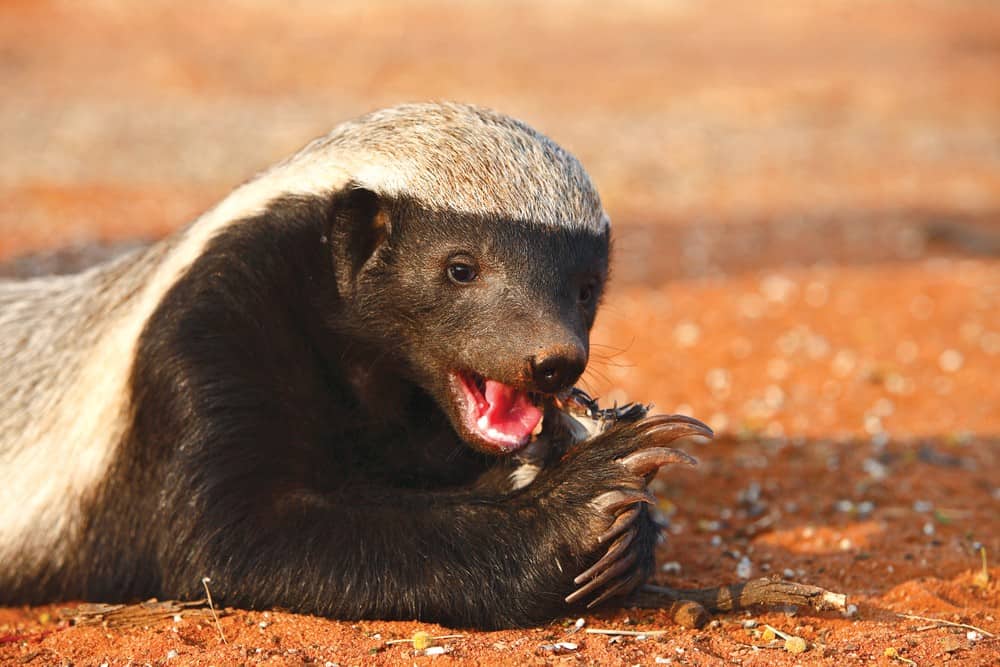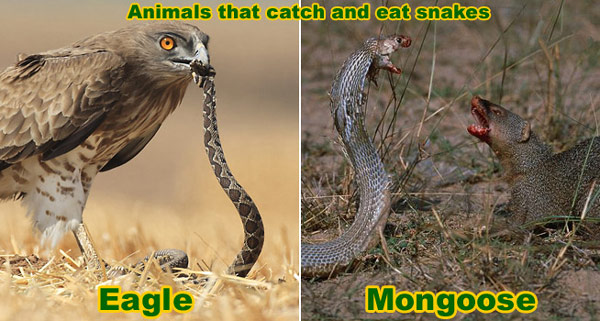Several animals such as mongooses, wild boars, wolverines, alligators, eagles, hawks, and king snakes prey on snakes. These predators are part of the natural food chain and play a crucial role in controlling snake populations.
In the wild, snakes must constantly be vigilant against these formidable foes to ensure their survival. Snakes are a fascinating and diverse group of reptiles found in various ecosystems around the world. While they are skilled hunters themselves, they are also targeted by a range of predators.
Understanding the predators of snakes is essential for appreciating their ecological role and the complex web of interactions in the natural world. From the agile mongoose to the powerful eagle, each predator plays a part in maintaining the delicate balance of nature. Let’s explore the diverse array of animals that hunt and consume snakes, shedding light on this captivating aspect of wildlife.
The Circle Of Life: Snakes On The Menu
In the circle of life, snakes are on the menu for a variety of predators. Animals such as mongooses, wild boars, wolverines, and alligators feast on snakes, along with birds like eagles, falcons, and hawks. The natural world showcases a diverse array of creatures that hunt and consume these slithery reptiles.
Snakes are fascinating creatures that can be found in almost every part of the world. While they are known for their ability to hunt and eat a variety of prey, they are also on the menu for many other animals. In this article, we will explore the natural selection in action and the food chain where snakes fit. Let’s take a closer look at the predators of snakes and what eats a snake.Natural Selection In Action
The circle of life is a never-ending cycle of birth, death, and survival. Natural selection is a process by which organisms that are better adapted to their environment tend to survive and reproduce more than those that are less well adapted. Snakes have been around for millions of years and have evolved to become efficient predators. However, they are not invincible and are preyed upon by several animals.The Food Chain: Where Snakes Fit
Snakes are an important part of the food chain and play a vital role in maintaining the balance of ecosystems. They are secondary or tertiary consumers and feed on a variety of prey such as rodents, birds, insects, and other reptiles. However, they are also vulnerable to predators such as eagles, hawks, falcons, herons, badgers, weasels, wild cats, and mongoose. Some snakes are cannibalistic and will even eat other snakes. Here are some animals that eat snakes:- Eagles, Falcons, and Hawks
- Cranes
- Secretary Birds
- Badgers
- Weasels
- Wild cats
- Mongoose
- King snakes

Credit: www.ultimatekilimanjaro.com
Birds Of Prey: The Winged Hunters
Eagles And Hawks: Masters Of The Sky
Eagles and hawks are renowned as expert hunters of the skies, preying on various creatures including snakes. Their sharp talons and keen eyesight make them formidable predators in the bird kingdom.
Owls By Night: Silent Predators
Owls, the silent nocturnal predators, are skilled in hunting snakes under the cover of darkness. Their stealthy approach and powerful talons enable them to catch their prey with precision.
Mammalian Menaces: Furry Foes
When it comes to preying on snakes, mammals are formidable adversaries. From the renowned mongoose to the smallest domestic cat, these furry creatures pose a significant threat to their slithery counterparts. Let’s delve into the world of mammalian menaces and explore the foes that snakes encounter in the wild.
Mongoose: The Famed Snake Fighters
The mongoose, with its remarkable agility and lightning-fast reflexes, is a legendary adversary of snakes. This sleek mammal is equipped with sharp teeth and a fearless demeanor, making it a formidable foe for even the most venomous serpents. With its uncanny ability to evade snake strikes and deliver swift, lethal bites, the mongoose has earned a fearsome reputation as a snake fighter.
Cats Big And Small: Feline Adversaries
From the majestic big cats, such as lions and jaguars, to the humble domestic feline, cats of all sizes pose a threat to snakes. Their stealthy movements and predatory instincts make them efficient hunters of these reptiles. Whether it’s the agile leopard stalking its prey in the wild or a house cat pouncing on a garden snake, felines are formidable adversaries in the ongoing battle between snakes and mammals.
Cannibalistic Kin: Snakes Eating Snakes
When it comes to the natural world, the concept of “survival of the fittest” takes on a whole new meaning. Snakes, often viewed as formidable predators themselves, are not exempt from the food chain. In fact, snakes are known to exhibit cannibalistic behavior, with some species preying on their own kind. This phenomenon of snakes eating snakes sheds light on the fascinating and sometimes brutal nature of the animal kingdom.
Kingsnake: The Royalty Of Snake Predators
One of the most renowned predators of other snakes is the kingsnake, aptly named for its dominance in the snake hierarchy. With a diverse diet that includes other snakes, the kingsnake is equipped with powerful constriction abilities and an immunity to certain snake venoms. This enables the kingsnake to overpower and consume a wide range of snake species, establishing its position as a top predator within the snake community.
Cobra Conflicts: When Venom Meets Venom
When it comes to venomous snakes, such as cobras, conflicts can arise when they encounter their own kind. In the intense battle for territory and resources, cobras may engage in deadly confrontations, leading to cannibalistic behavior as one cobra preys upon another. These encounters not only underscore the fierce competition among cobras but also highlight the lethal nature of their venom when used against their own species.
Aquatic Assassins: Water Dwellers
When it comes to the natural world, snakes face threats from a variety of predators, and some of the most formidable ones lurk in the water. Let’s dive into the world of aquatic assassins and explore the water dwellers that pose a threat to these slithering reptiles.
Crocodiles And Alligators: Jaws Of Death
These ancient predators, with their powerful jaws and lightning-fast reflexes, are among the most fearsome hunters in aquatic environments. With an incredible bite force and stealthy hunting techniques, crocodiles and alligators are apex predators that strike fear into the hearts of many creatures, including snakes. Their ability to ambush unsuspecting prey makes them formidable foes for any snake venturing into their territory. Snakes, with their agility and quick movements, may be able to evade these predators, but a single misstep could lead to a fatal encounter.
Snakeheads: Fish With A Bite
Snakeheads are notorious for their predatory prowess and adaptability, thriving in various aquatic habitats. These fish are equipped with sharp teeth and an insatiable appetite, making them a threat to snakes that venture into their domain. With their ability to breathe air and survive out of water for extended periods, snakeheads are formidable adversaries for snakes, especially in shallow waters and marshy areas. Their predatory nature and ability to ambush prey make them a force to be reckoned with.

Credit: biomedicalsciences.unimelb.edu.au
Land Giants: From Boar To Badger
When it comes to the natural world, the hierarchy of predators is both fascinating and complex. In the realm of snakes, there are several formidable foes, including land giants such as wild boars and badgers. Let’s delve into the hunting habits of these creatures and their role in the ecosystem.
Wild Boars: Opportunistic Omnivores
Wild boars, also known as feral pigs, are opportunistic omnivores that inhabit various habitats, from forests to grasslands. Their diet includes a wide range of foods, from vegetation and insects to small mammals and reptiles. These formidable creatures are known for their foraging prowess, and their keen sense of smell aids them in detecting prey, including snakes.
When it comes to encountering snakes, wild boars are not deterred. Their powerful tusks and formidable strength enable them to take on and consume snakes, making them a significant threat to these slithering predators. Boars’ ability to root around in the underbrush gives them the advantage of stumbling upon unsuspecting snakes, adding to the perils that snakes face in the wild.
Badgers: Burrowing Hunters
Badgers are known for their burrowing prowess, creating intricate underground dwellings where they hunt for a variety of prey, including snakes. Their keen sense of smell and sharp claws make them formidable hunters, capable of tracking down snakes in their subterranean hideouts.
When it comes to confronting snakes, badgers use their powerful forelimbs and sharp claws to unearth and capture their prey. Their thick skin protects them from snake bites, allowing them to dispatch their serpentine quarry with relative ease. Badgers’ remarkable hunting abilities make them a force to be reckoned with in the realm of snake predators.
Creeping Threats: Small But Deadly
Hedgehogs: Spiky Snack Attackers
Hedgehogs may seem cute, but they are fierce predators for snakes.
Wolverines: Fierce And Fearless
Wolverines strike fear in snakes with their relentless hunting skills.

Credit: www.wildlife-removal.com
Human Encounters: Cultural And Ecological Impact
In the circle of predator and prey, snakes face a variety of foes. From agile mongooses to powerful alligators, nature’s lineup of snake predators is diverse and formidable. Even birds of prey like eagles and hawks pose a threat to these slithering reptiles.
Snake Hunting Traditions
Snakes have been hunted for centuries for their meat, skin, and other valuable parts. In many cultures, snake hunting is a traditional practice that has been passed down from generation to generation. However, excessive hunting has led to a decline in snake populations, making some species endangered. In some parts of the world, snake hunting is still legal. For example, in India, snake charmers hunt cobras for their venom, which is used to make anti-venom serum. In the United States, some states allow the hunting of non-venomous snakes for their meat and skin.Conservation Efforts: Balancing The Scales
Conservation efforts are crucial to maintaining a healthy ecosystem and protecting endangered species. Many organizations around the world are working to protect snake populations and their habitats. One example is the Snake Conservation Society, which works to raise awareness about the importance of snakes in the ecosystem and protect their habitats. The society also works with local communities to promote sustainable snake hunting practices and reduce human-snake conflicts. Another example is the Snakebite Healing and Education Society, which provides education and healthcare services to communities affected by snakebites. The society also works to develop alternative sources of income for snake hunters, such as ecotourism and sustainable farming practices. In conclusion, human encounters with snakes have both cultural and ecological impact. Traditional snake hunting practices and excessive hunting have led to a decline in snake populations, making some species endangered. However, conservation efforts are crucial to balancing the scales and protecting snake populations and their habitats.Frequently Asked Questions
What Are The Predators Of Snakes?
Badgers, weasels, wild cats, and domestic cats are predators of snakes. Additionally, raptors like eagles and hawks, cranes, and secretary birds also prey on snakes. Other snake predators include the mongoose, honey badgers, and some snake species such as the king snake.
What Animal Eats A Snake In A Food Chain?
Many animals eat snakes, including eagles, hawks, and cranes in the food chain. Additionally, other predators like the mongoose and king snakes also hunt and consume snakes.
What Animal Kills Snakes?
Mongoose, king snakes, eagles, hawks, and honey badgers are animals that hunt and kill snakes.
What Is The Snake’s Greatest Enemy?
The snake’s greatest enemy is the mongoose, known for its speed and ability to bite the snake before it strikes.
Conclusion
Snakes have various predators like eagles, hawks, and even mongoose that hunt and kill them. Understanding the natural enemies of snakes is crucial for their survival in the wild. By knowing what eats snakes, we gain insight into the intricate balance of ecosystems.


